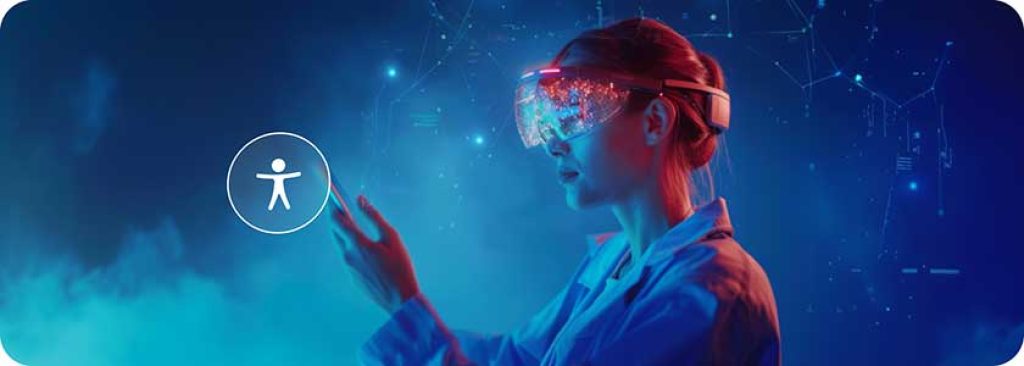Smart Glasses for the Visually Impaired – Technological Advancements in Accessibility
Reach For Tech Specs For Sharper Insight, Brighter Prospects
Smart glasses are wearable computer devices with transparent displays that overlay digital information onto the real world. For people with low vision, smart glasses offer a new wave of assistive technology. Part of a surge of technological innovation around accessibility that focuses more on wearables rather than typical mouse and keyboard, these glasses use built-in cameras and sensors to capture visual information and process it using powerful microprocessors. This processed information is then displayed on the lenses in a way that can be customized to a user's specific needs.
Smart glasses can significantly improve accessibility for visually impaired individuals in several ways. For those with difficulty reading, text-to-speech features can convert printed text into spoken audio. Object recognition allows users to identify items in their surroundings, while facial recognition can announce the presence of familiar people. Navigation assistance provides real-time guidance, helping users avoid obstacles and follow directions. Integration with mobile devices like smartphones expands functionality even further.
How Do Smart Glasses Work?
Smart glasses act like mini cameras for the visually impaired, capturing their surroundings. The gathered information is then transformed into helpful feedback. Users can hear descriptions of objects or have text labels in their environment read aloud, or they may feel vibrations to help them navigate. Even people with very limited vision can gain valuable advantages by using smart glasses technology. Smart glasses have advanced visual displays that can amplify visuals. They can also translate the visual world into sounds or touches, opening doors to a more independent life. For smart glasses brands like Envision leveraging Aira AI, and for some smart glasses models from other manufacturers, AI and automation are major components of their featured functionality; for others, they’re a minor or nonexistent part of their version of the technology. Some smart glasses may incorporate a connection with a real person at the other end, offering personalized guidance and direction in real-time with the accuracy and the potential flaws of manual human service. Traditional glasses imprints and well-known technology manufacturers, including the perennially popular RayBan and Bose, have created smart glasses that fit their highly respected trademark values, each with the features and functions they consider most attractive and useful, with varying success. RayBan Stories were chosen as the Best Housekeeping number one pick for smart glasses this past August, while Bose has since discontinued most of their Frames line due to mixed reviews and what users considered disappointing audio. Nevertheless, both well-established names including Amazon and freshly minted tech develop companies continue to attempt their own versions of this smart tech.

Key Technological Features In Smart Glasses For Low Vision
Some of the helpful features offered by smart glasses are also of use to people with perfect vision. But specifically for people who have low vision or visual impairment, some of the more useful smart glasses features include:
- Real-Time Object Recognition
This feature identifies people, products, and landmarks, so users can recognize and interact with objects in their environment. Verbal descriptions are given through earpieces or bone conduction headphones. - Magnification
This smart glasses feature enlarges text and objects for easier viewing. - Navigation Assistance
Leveraging GPS and spatial awareness technology, smart glasses offer guidance and directions in real-time. They provide turn-by-turn directions and obstacle avoidance, helping users safely navigate outdoor and indoor spaces, even in places that are new and unfamiliar to them. - Facial Recognition Technology
This feature announces the presence of familiar faces. By identifying and providing information about the people around them, users can engage more confidently in social interactions. Currently, this feature is only available to identify people that have already been entered into the glasses database. This is because recognition must relate facial identity to some readily available information, and most commercially available smart glasses today do not come preloaded with vast facial recognition databases. - Integration with Mobile Devices
Most smart glasses on the market now are compatible with mobile phones.This type of connectivity means users can access their smartphones or other mobile device’s functionalities hands-free, using voice commands or gestures. And, the smart glasses can also work together with the mobile phone for:
- Connectivity
Smart glasses typically connect to the user’s phone via Bluetooth. This allows them to exchange information and instructions. Smart glasses themselves typically cannot directly make phone calls or run social media apps due to processing limitations and lack of interfaces. However, they can work with a cell phone as a companion device, to control the phone and access communication features like voice assistants which can initiate calls, to dictate text messages or social media posts, and to receive audio notifications of incoming calls or messages. - Processing Power
Many smart glasses don't have the processing power to handle complex tasks on their own. They rely on the phone's processing power for things like running apps, interpreting data, and generating responses. - Information Sharing
The phone acts as a central hub. It sends information to the glasses for display (like directions on a map) and receives information from the glasses (like voice commands).
- Connectivity
While most smart glasses rely on phones, a few advanced models might have some standalone functionality or connect to computers.

- Text-to-Speech Using OCR (Optical Character Recognition)
Here's how smart glasses leverage OCR and other technologies to offer text-to-speech services:
- Capturing Text
Smart glasses have a tiny embedded camera. This camera continuously takes pictures of what the user sees in the real world, including any text on screens or physical objects. - Optical Character Recognition (OCR)
Next, software within the glasses (or sometimes on the connected phone) uses OCR to analyze the captured image and convert the squiggles into actual letters and words. - Text-to-Speech (TTS) Engine
Once the text is recognized, a text-to-speech engine comes into play. This software transforms the digital text into an audio stream, essentially giving the text a voice. In most cases this will be a synthetic voice. Sometimes, users can set up options to use a synthesized voice that’s based on their own. This functionality is offered by other devices, not within the smart glasses themselves. - Audio Information Delivery
Finally, the converted speech is delivered to the user through speakers or bone conduction headphones connected to the glasses. The user hears the text read aloud, providing information about their surroundings.
- Capturing Text
Additional Smart Glasses Features
Not all smart glasses offer the following options, but they are available in some models:
- Augmented Reality (AR)
Some smart glasses overlay recognized text brought in through the TTS and OCR features we just described directly onto the user's field of view through AR. This can be helpful for situations where the physical text is small or hard to see, for users who do have some visual impairment but are still able to see larger text. - Customizable Visual Aids
Many smart glasses models offer the ability to magnify text or adjust contrast and color settings, making it easier for those with visual impairment but some vision to read or discern details. - Gesture Recognition
Available in some models, this option allows users to control the device and navigate its features through simple hand movements, reducing reliance on touch screens or buttons.
These smart glasses features empower people with low vision to navigate their environment more independently, access information more easily, and participate more fully in daily activities. Some features may not be suitable for those with severe vision loss or total blindness. However, continuous advancements in smart glasses technology promise even greater accessibility options in the near future, and making them a critical tool in the arsenal of technologies aimed at breaking down barriers for individuals with disabilities..
The Impact of Smart Glasses Technology on Accessibility
By providing real-time information about surroundings, navigation assistance, and object recognition, smart glasses offer users a way to move through their surroundings with greater confidence and autonomy. Tasks like reading signs, identifying objects on shelves, and following directions become more manageable. Text-to-speech conversion can facilitate communication by reading aloud incoming messages or social media posts. And, smart glasses facial recognition can help users identify and interact with familiar people. By informing users about who is in their vicinity, they can make social engagements more accessible and meaningful. And, with the help of smart glasses in identifying faces and expressions, people with visual impairments can respond more appropriately in conversations, reducing barriers to effective communication. These options widen horizons for people with visual disabilities, opening up options for social interaction and participation in everyday activities.

Web Accessibility and Smart Glasses
For any effective online use of smart glasses, device and content compatibility is essential. The integration of smart glasses with web content and applications can be a wonderful way to extend and expand accessibility benefits. Developers must prioritize the compatibility of their digital platforms with these devices to ensure users can fully engage with web-based resources. This means designing websites and applications that can interact seamlessly with the technologies used by smart glasses, such as text-to-speech converters and gesture-based navigation.
While this sounds complicated, it doesn’t have to be. Following best practices for good development and design, like clear labeling and correct coding, logical content and page structure, and other techniques that are recommended approaches in any case, should not add to the design and development team task load too greatly. What may take a little more initial training if it isn’t already in place is the understanding and prioritization of following accessibility guidelines like the Web Content Accessibility Guidelines (WCAG) set forth by the World Wide Web Consortium (W3C). The WCAG outlines best practices for creating content that can be perceived, operated, understood, and navigated by people with disabilities, including those using assistive technologies like smart glasses. Following these guidelines means a wider user base can access information and interact with digital platforms effectively.
The Web Content Accessibility Guidelines (WCAG) provide a framework for creating web content that is accessible to people with a wide range of disabilities. To make digital platforms more accessible to all, including visually impaired users wearing smart glasses, web developers should follow established guidelines and regulations, starting with the WCAG, and taking into account any local or industry-specific laws.
Accessibility recommendations based on WCAG standards include:
- Adding Text Alternatives
A first step to making any digital content accessible includes providing text alternatives for non-text content, allowing it to be converted into other forms people need, such as large print, Braille, speech, symbols, or simpler language. - Confirm Keyboard Functionality
It’s important to check that all functionalities on a website, web app or other digital content are available from a keyboard for users who cannot navigate with a mouse. - Provide Multiple Perception Options
It is critical to create content that can be presented in multiple different ways without losing information or structure. This is vital for users employing text-to-speech technology such as smart glasses technology, and in general means setting up content in such a way that users with a visual disability can access information through another method of perception, like hearing, and that users with a hearing impairment can engage with data visually, or through another method. - Appropriate Text & Color Settings
It’s important to remember that websites must have sufficient color contrast for text to be distinguishable from its background. And users with low vision must be able to resize text to read more easily.
By sticking to these and other important accessibility guidelines, and through continually testing their websites for accessibility, digital content and platforms with both automated tools and with users who employ assistive technologies, developers and designers can create more inclusive and accessible digital environments. This not only benefits individuals with visual impairments, it also elevates the overall user experience for a broader audience.

Accessibility’s Future: Envisioning A More Inclusive Digital World
Technological advancements like smart glasses that are already available offer a glimpse into a near future where adding accessibility is a given in any space, and technology offering greater accessibility is an integrated part of daily life for people with visual impairments and many other disabilities. The power to navigate physical spaces with greater ease, access information independently online, and participate more fully in social interactions is a tremendous advancement for individuals. It also paves the way for a more inclusive society. As technology continues to develop, so too will the potential to break down unnecessary barriers and create an equal footing for all, where everyone can access the same information and services. People with disabilities can and must remain integral, active participants in the human experience, enjoying the same levels of engagement and access as others. This vision that needs neither eyes nor smart glasses to see it is not only a possibility, it’s a reality we can create and maintain as a result of technologies and approaches we are already implementing and improving: a world where people with disabilities are offered the opportunities and the tools to reach their full potential, contributing their unique voices and talents to the richness and diversity of our social fabric.
FAQs
Currently, smart glasses are primarily designed for people with low vision. While some features now offer only limited benefits for those with severe or total vision loss, the technology is constantly evolving, and we remain optimistic.
Smart glasses for low vision can range in price depending on features and capabilities. Costs can start around $1,000 USD and go higher.
Some vision rehabilitation centers or low vision clinics may offer smart glasses demonstrations or loaner programs.
Manufacturers have developed smart glasses with features and designs suitable for children. These models are lighter and more durable, and usually come with interfaces that are easier for young users to navigate, making the technology usable from an early age.
Absolutely. Smart glasses complement traditional assistive devices rather than replace them. They offer additional information and support that can enhance the effectiveness of canes, guide dogs, and other aids, providing a more comprehensive assistance system for the user. Of course, smart glasses are unlikely to replace guide dogs entirely. Guide dogs provide more than just obstacle detection; they offer companionship and emotional support that smart glasses cannot replicate.
It’s important to be aware that privacy is a critical consideration. Look for smart glasses with clear data privacy policies and user controls regarding facial recognition features. Most smart glasses manufacturers and compatible app developers are also working to keep devices and features compliant with privacy laws and regulations, incorporating safeguards like data encryption and consent protocols to protect users and those around them.









